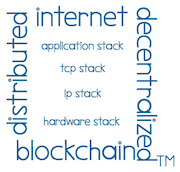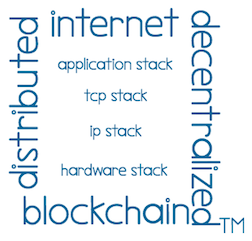Welcome to the Stack CafeTM — The internet was on the minds of few people as far back as the [sg_popup id=”7″ event=”hover”]1960’s*[/sg_popup] and early 1970’s (early version of a decentralized connected grid/network in 1973 Arpanet on wikipedia ):

The grid above shows the inter-connected nodes or computers connecting to each other to form the decentralized internet network/grid to send/receive information or data in the early 1970’s. The images below show how computers talk to one another (via the layer or protocol stack and packets). (See – “How The Internet Works?” – published on Stanford University’s website.)
TWO COMPUTERS CONNECTED TO THE INTERNET

PROTOCOL STACKS AND PACKETS
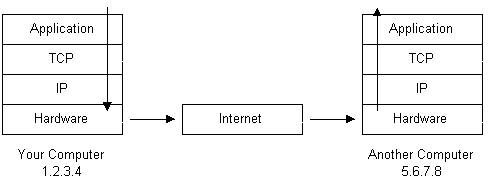
Today, the modern internet (some 20+ years old from the introduction of “www”) is far more complex in its size and implementation. Presently, some parts of the internet are decentralized (hardware, IP and TCP) while the application layer (stack) – in particular, has become more and more centralized (e.g., more data controlled by fewer and fewer companies – think social media, search, devices, online commerce, walled-gardens…). The current system with all of the good things is not completely fulfilling its original vision – full decentralization (i.e., we should own our data…). And, apparently, some other people and companies believe the same thing. 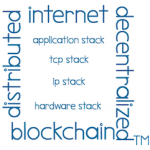
One company in particular – BlockStack, and the people involved with Blockstack – its team, its investors, its open source community of developers, its users and its open support community – appear to believe in a fully decentralized internet (read the Blockstack documents e.g., white paper…).
Basically, it appears that Blockstack wants to re-decentralize the internet, in particular – the application layer (stack) of the internet (e.g., see – Blockstack and its documents e.g., white paper…). Blockstack’s team and others, are working tirelessly to bring us new tools, infrastructure and applications – with a tie-in to the distributed ledger or blockchain. And with these new tools, Blockstack enables the user to own his/her/its data and maintain and protect his/her/its privacy and security (e.g., encrypted decentralized storage, authentication & identity). How is Blockstack doing this? Well, not to go to far into the stack, Blockstack is developing key tools and infrastructure so that software developers and programmers (coders) can build single-page applications (dApps – (e.g., in javascript) in which the user controls not only his/her identity & authentication (e.g., think encrypted identification) but is also in control where and how his/her information (data) is stored on the decentralized internet.
So one might envision – one universal form of encrypted identification that is unique to the user that allows the user to securely participate in a decentralized internet and control his/her data that is generated from using the decentralized internet (e.g., imagine an internet with no middlemen, no passwords, and no massive centralized data repositories to breach).
Just imagine, if you have control (e.g., identity, data, storage and it is secure) and not the centralized companies, the possibilities appear to go on and on… And, just like the early days of the network/internet (see above image from 1973), Blockstack is at the early stage of building the re-decentralized internet.
Please go see for yourself – visit Blockstack – and visit here again for updates and information on, among other things, Blockstack’s vision for the re-decentralization of the internet and the stack.
Here is a screenshot of Blockstack’s home page at www.blockstack.org.
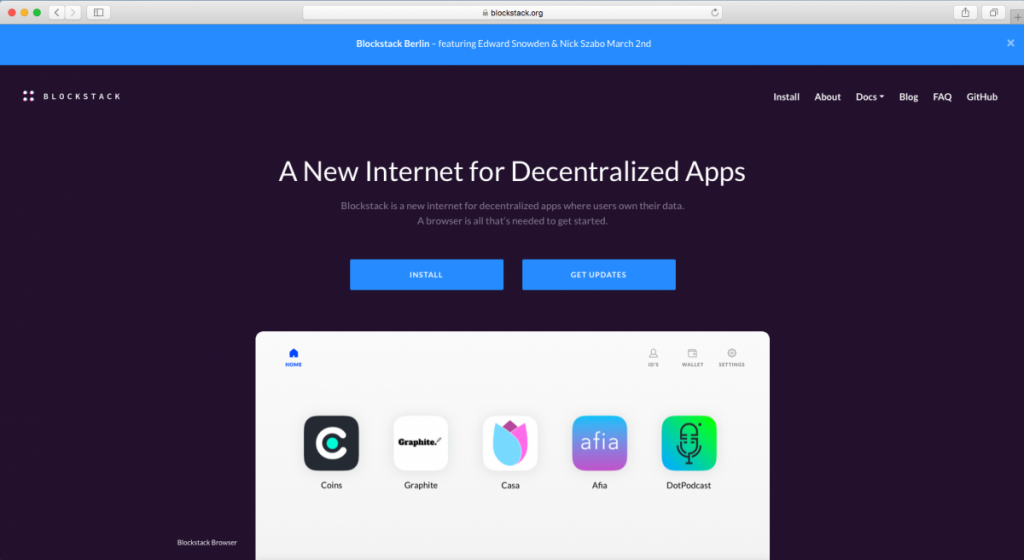
Note: If you do not have the Blockstack browser, please see this link (note – to enable the full functionality of any dApp built for the Blockstack ecosystem (e.g., building a new internet, a decentralized internet, re-decentralizing the internet) you need to use the Blockstack browser).
Thanks again for visiting The Stack CafeTM and we look forward to hearing from you. Please help us put out the word on Web3.0 by posting a comment below and signing up for e-mail notifications for future updates (right side-bar). Let’s help build the new internet | The Decentralized WayTM. A decentralized internet | The Way The FutureTM.
